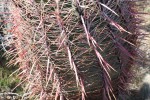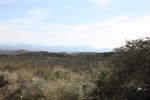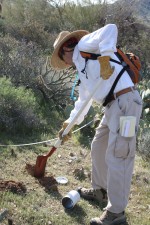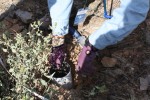The Central Arizona–Phoenix (CAP) Long-Term Ecological Research (LTER) program and the McDowell Sonoran Conservancy, a non-profit conservation organization working with the City of Scottsdale, are collaborating on a citizen science monitoring project in the McDowell Sonoran Preserve, a mountainous area directly adjacent to the city.
CAP is working with citizen scientists through the Conservancy’s Field Institute to monitor ground-dwelling arthropods (mostly non-flying insects and arachnids). Arthropods have short lifespans and, as such, may quickly respond to environmental change. While people do not often value crawling insects and spiders, these organisms can tell us a lot about the health of an ecosystem.
CAP LTER’s former site manager, Stevan Earl, began the collaboration with the Conservancy in 2012, working with the Field Institute staff, stewards, and citizen scientists. The arthropod monitoring program in the Preserve uses the same protocols that CAP has used for almost two decades of monitoring ground-dwelling arthropods throughout Phoenix metropolitan and surrounding desert areas.
In collaboration with community scientists and Field Institute staff, Stevan established five paired transects for monitoring arthropods in the Preserve. At each sampling location, one transect is situated close to the boundary of the Preserve (and fringe development) and another located further into the Preserve away from development. This sampling design will help scientists to understand the possible impacts of urbanization on ground-dwelling arthropods.
Arthropod monitoring uses a very simple, yet effective, tool: cups placed in a hole with the lip of the cup flush to the ground, called a “pitfall trap." Traps are covered with a lid, which is removed when quarterly monitoring begins. Insects and spiders that walk up to the edge of the cup fall into it and cannot climb back out due to the sloped sides.
Conservancy citizen scientists worked with Stevan to establish lines of pitfall traps, and collect the specimens in the cups about three days after the pitfall traps are set. They transfer the specimens to containers, which are transported to CAP’s entomology lab at Arizona State University where trained scientists and students sort and identify the arthropods.
To date, there have been 12 quarterly collections of arthropods at the five sites in the Preserve. Over 11,000 specimens have been collected. Ants, springtails, and mites make up the majority of the arthropods collected, although the arthropod community in the Preserve is incredibly diverse.
Scientists have identified one invasive ant species from this monitoring, the rover ant, which is native to Argentina. While the impact of this species on the Preserve’s ecosystem is not yet known, its presence is indicative of the challenges in managing a preserve in a rapidly globalizing world. This also indicates the importance of monitoring over the long term.
Early findings suggest that the Preserve may have a more diverse set of arthropods relative to other desert sites that CAP monitors. This is good news for the Preserve and establishes a baseline for measuring change over time.
The Field Institute featured arthropod monitoring in the October 2014 issue of their project publication, The Field Insider, which included a profile of Stevan, who now works with CAP in a data management role but continues his work with the Conservancy.

 Enlarge this image
Enlarge this image


